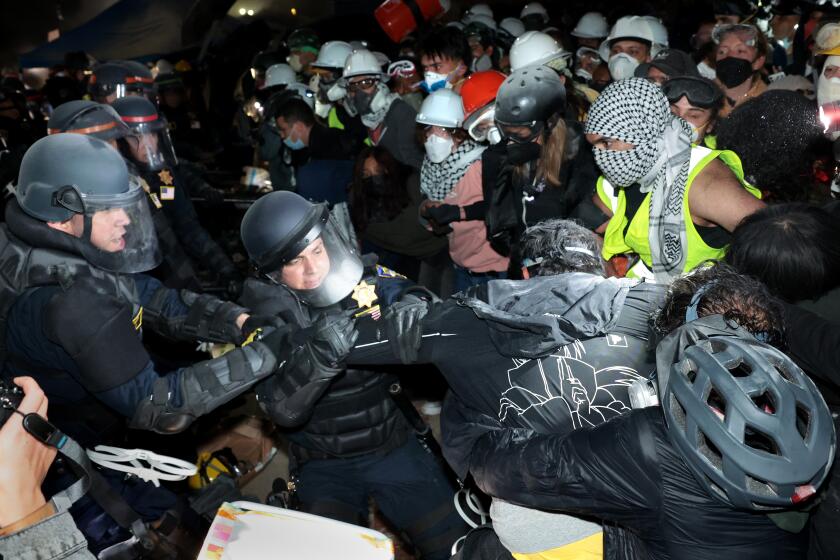LEARNING THE HARD WAY : Fledgling Instructors Try to Ease Staffing Shortage
They are artists without studios, scientists without labs or housewives eager for a career.
But because they speak Spanish, know math or are willing to work with disabled children, they have found jobs this fall in the hardest to fill teaching posts in the Los Angeles Unified School District.
Next week, about 2,000 of these neophyte instructors, all without full college teaching credentials, will take charge of public school classrooms packed with squirming youths.
More than 400 of the new hires gathered last week for a mandatory workshop in classroom survival skills. For many, the two-day crash course will be their primary source of teacher training.
At the close of the sessions, some were writing their first lesson plans in brand new books, and everyone was looking for any tidbit of information that could help them in their first solo classroom encounters.
“Don’t eat too much for lunch,” advised one veteran mentor teacher. “You can’t be feeling lethargic, especially in the afternoon.”
Lourdes Enriquez, who has taught in a year-round kindergarten classroom in the inner city since July, said her first week was the worst.
“Discipline didn’t exist. They were fighting, wanting to go to the bathroom, running around,” she said.
Her method for reining in the little ones?
“I bribed them with cookies,” she said, adding that she recently learned through her mentor teacher to identify and compliment good behavior rather than doling out treats as a way to teach discipline.
Although the cram session went a long way toward easing their first-day-of-school fears, some educators are concerned that the increasing number of such “emergency credentialed teachers” does not bode well for the quality of public education.
“It’s a shame, isn’t it?” said Jeannie Oakes, assistant dean at the UCLA Graduate School of Education and Information Services. “Even though you have good intentions and your heart is in the right place and you care about kids, it can be a very bruising experience to be on your own without any background, experience and support. . . . There are skills that are needed, especially when working with kids who have difficulties.”
Because the teacher supply does not meet the high demand in several specialty areas--bilingual education, math and science classes and special education--district officials say they are backed into a corner and have no choice but to hire teacher wanna-bes.
“We could hire every fully credentialed bilingual teacher coming out of college and still fall short,” said Michael Acosta, administrator of employee operations. “It’s the same for math and special education.”
*
A fully credentialed teacher not only has earned a baccalaureate degree, but has received 30 post-graduate units from state-accredited college or university schools of education. Typically, this includes a semester learning about the latest teaching methods and the principles of human learning and another semester of closely supervised student teaching.
Basically, all that is needed under state education codes to obtain an emergency credential is a bachelor’s degree, passage of a state basic skills exam and a tuberculosis test, and proof that the teacher is taking at least six units a year toward the full credential.
They are investigated to determine if they have criminal records, and teachers can be dismissed for felony and other convictions that include drug abuse, sex offenses, violent crimes and grand theft.
At last week’s training seminars--organized by United Teachers-Los Angeles and the district--many of the teachers-to-be said what they lacked in experience they make up for with an enthusiasm about their new vocation.
“I love kids, I like helping people,” said Alejandro Ornelas, fresh out of Cal State L.A. “Seeing the children change, seeing them learn, makes the job all worth it.”
Although the district does not keep detailed profiles of its pool of emergency credentialed teachers, officials say it is rare for one to be hired without classroom experience. Most, they say, have been teacher’s aides or substitute teachers, part-time jobs that propelled them to seek out the profession.
“We aren’t all just fresh off the pavement,” said Wendy Oakford, 42, who has a Utah teaching credential and is returning to the profession now that most of her children are grown.
“Just because you have an emergency credential doesn’t mean that you are not qualified to teach,” said Kathryn DeSensi, 42. “And having a credential teacher doesn’t necessarily mean you are a quality teacher.”
*
The tough realities of teaching, however, tend to quickly wear down their ranks. Nearly half are likely to resign within five years, far higher than the rate of fully credentialed teachers, said Thomas Killen, district administrator in charge of personnel research.
In the past three years, the numbers of emergency credentialed teachers in the district has almost doubled from 1,083 in the 1991 school year to 2,051 in 1994, a trend that university education experts say reflects the fact that they cannot attract and churn out enough qualified teachers these days.
The high numbers in the emergency corps, said Carolyn Ellner, dean of the school of education at Cal State Northridge, “mean that many of the children of Los Angeles are being shortchanged. . . . We know that there is a direct correlation between good teaching skills and the ability of children to learn.”
Particularly worrisome to UCLA’s Oakes is that the most challenging of teaching posts are being filled with the least experienced instructors.
“The fact is that some children can be thrown away educationally by not having well-trained, well-qualified teachers, and we seem to tolerate it,” she said.
More to Read
Sign up for Essential California
The most important California stories and recommendations in your inbox every morning.
You may occasionally receive promotional content from the Los Angeles Times.






